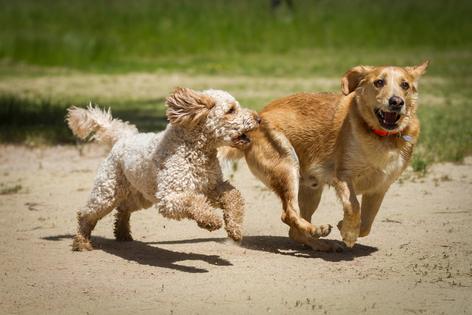My Pet World: Friendly, floppy, and full of life -- Training tips for social dogs
Dear Cathy,
Our adorable and lovable great-grandson Labradoodle, Franklin, has a rather unusual behavior. This past weekend, our daughter and son-in-law brought Franklin along for a fundraising walk around our local fairgrounds.
At one point, he suddenly flopped down on the pavement – head and paws down. At first, I thought he was just tired, but our daughter knew what was happening. In the distance, another dog was approaching. Franklin stayed down until the dog got closer, then popped up and lunged against the leash to greet it. He repeated this several times whenever another dog came into view.
Also, if he sees two people hugging, he’ll jump up to join in, placing his paws around them as if hugging too. It’s a sweet gesture with family, but he also tries it with strangers during daily walks.
Is this bizarre behavior? Is it breed-related? Or just Franklin being Franklin? He’s the sweetest dog and loves all creatures, but we realize this behavior probably shouldn’t be encouraged. Do you have any advice for managing it on walks?
— Kathy, Schererville, Indiana
Dear Kathy,
While his behavior may seem “bizarre,” it’s actually not uncommon in friendly, highly social dogs. Labradoodles are known for their friendly, energetic personalities, which can sometimes come across as hyper, especially during puppyhood and adolescence. That energy comes from both sides of their lineage: Poodles are intelligent and active, while Labradors are enthusiastic and athletic. Combine the two, and you get a dog who’s social, smart, and always ready for action.
The “flop-and-freeze” move is often a form of anticipatory behavior. Franklin may be lying down in response to spotting another dog, then springing up and lunging as a way to say, “Here comes a friend! I can’t wait!”
As for his “hugs,” it’s adorable with family but, as you noted, not ideal with strangers. Dogs who jump on everyone often struggle with impulse control. What Franklin needs now is some guidance on how to express his enthusiasm in more appropriate ways, especially during walks. Training is key.
When another dog approaches, I recommend teaching Franklin a reliable “watch me” or “leave it” cue to redirect his focus to whoever is walking him. Start in a low distraction setting with treats and gradually practice in more stimulating environments. Work on loose-leash walking and reward calm behavior when passing other dogs. If he flops down, gently encourage him to keep moving with a treat and praise him for walking past politely.
The same goes for human interactions. Ask him to “sit” or “stay” when people are nearby and reward him for keeping all four paws on the ground. A short leash or front-clip harness can also give you more control when needed.
Labradoodles, like most dogs, need plenty of physical exercise and mental stimulation to stay balanced. Without it, they may become restless, jumpy, or overly excitable. What often looks like hyperactivity is simply a young, intelligent dog who hasn’t yet learned how to manage all that enthusiasm.
Consistent training and the use of puzzle toys can help focus Franklin’s energy and challenge his mind, making him more confident and easier to live with. Dogs thrive with structure, clear expectations, and positive outlets for both their brains and bodies.
Dear Cathy,
Reading your column on feral cats reminded me of a story. We summer on Long Beach Island in New Jersey, where a friend of mine – who helped get the local animal shelter built – has been running a TNR program for many, many years.
Back in the 1970s, people were constantly complaining about all the feral cats on the island. It’s a beach community, so people tend to dump their pets. (As my TNR friend likes to say, “The cat’s not sitting by the car with a bag packed. People just leave them behind.”)
Eventually, after enough complaints, the township removed all the feral cats from the island. Within months, those same people were calling to complain about a rat and mouse problem. Some people are never happy.
— Barbara, Barnegat Light, New Jersey
Dear Barbara,
Your story illustrates what can happen when feral (or community) cats are all removed without considering the consequences. Eliminating them entirely often leads to a spike in rodent populations. When you say “removed from the island,” it’s important to clarify that, back in the 1970s, that meant the cats were euthanized – not relocated.
TNR offers a far more humane approach to handling abandoned cats. It stabilizes community cat populations and allows for natural attrition over time, reducing nuisance complaints and making it easier for neighborhoods to peacefully coexist with them.
_____
_____
========
(Cathy M. Rosenthal is a longtime animal advocate, author, columnist and pet expert who has more than 25 years in the animal welfare field. Send your pet questions, stories and tips to cathy@petpundit.com. Please include your name, city, and state. You can follow her @cathymrosenthal.)
©2025 Tribune Content Agency, LLC.
(c) 2025 DISTRIBUTED BY TRIBUNE MEDIA SERVICES, INC.












Comments